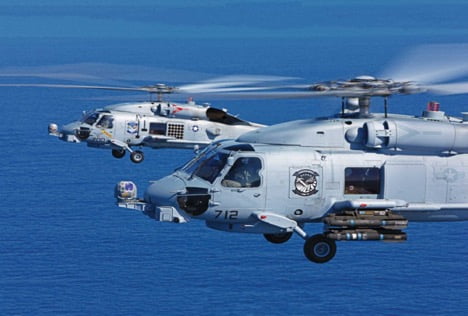Clearly, as the challenge from the Chinese Navy grows, the US needs to work with core allies and partners to shape more effective defenses in the years ahead.
India is clearly a partner in this effort.
According to an article published in April 2019by our partner India Strategic, the US State Department has approved sale of MH-60R ASW helicopters to India.
New Delhi. The US State Department has approved the sale of 24 Lockheed Martin MH-60R anti-submarine helicopters to India, paving the way for final negotiations to set the price and what onboard equipment and weapons will be required by the Indian Navy.
The Defense Security Cooperation Agency (DSCA) of the State Department announced approval on April 2, under the Foreign Military Sale (FMS) programme “for an estimated $2.6 billion” for the multi-mission helicopters. Procedurally, DSCA has to notify the US Congress, which it did, saying the proposed sale will strengthen the US-Indian strategic relationship and “improve the security of a major defensive partner which continues to be an important force for political stability, peace, and economic progress in the Indo-Pacific and South Asia region.”
This is the first time that the Indian Navy will get one of the most advanced Anti-submarine helicopters, equipped with Raytheon’s MK-54 torpedoes, Lockheed Martin’s Hellfire missiles, Advanced Precision Kill Weapon System (APKWS) and its Rockets, Night Fighting systems, sophisticated radars and secure communication devices. Just about the same that the US Navy uses.
The Indian Navy had decided about five years ago to go in for this helicopter, then Made and Sold by Sikorsky, and as usual there were procedural hiccups in India. Later, Lockheed Martin acquired Sikorsky, and the deal was closed.
Air Vice Marshal AJS Walia (Retd) and later Dr Vivek Lall, Lockheed Martin’s Vice President for Strategy and Business Development, coordinated the negotiations with Indian authorities. The Ministry of Defence will now set up a Price Negotiations Committee (PNC) to finalise the deal, and the supply of helicopters will commence around three years after the first payment is made.
Indian Navy sources said the helicopters are needed at the earliest possible, and the US company may be asked to expedite the delivery on As Soon As Possible basis.
As for the Weapons and Systems on board, DSCA said:
The Government of India has requested to buy twenty-four (24) MH-60R Multi-Mission helicopters, equipped with the following:
Thirty (30) APS-153(V) Multi-Mode radars (24 installed, 6 spares); sixty (60) T700-GE-401C engines (48 installed and 12 spares); twenty-four (24) Airborne Low Frequency System (ALFS) (20 installed, 4 spares); thirty (30) AN/AAS-44C(V) Multi-Spectral Targeting System (24 installed, 6 spares); fifty-four (54) Embedded Global Positioning System/Inertial Navigation Systems (EGI) with Selective Availability/Anti-Spoofing Module (SAASM) (48 installed, 6 spares); one thousand (1,000) AN/SSQ-36/53/62 sonobuoys; ten (10) AGM-114 Hellfire missiles; five (5) AGM-114 M36-E9 Captive Air Training Missiles (CATM); four (4) AGM-114Q Hellfire Training missiles; thirty-eight (38) Advanced Precision Kill Weapons System (APKWS) rockets; thirty (30) MK-54 torpedoes; twelve (12) M-240D Crew Served guns; twelve (12) GAU-21 Crew Served guns; two (2) Naval Strike Missile Emulators; four (4) Naval Strike Missile Captive Inert Training missiles; one (1) MH-60B/R Excess Defense Article (EDA) USN legacy aircraft.
Also included are seventy (70) AN/AVS-9 Night Vision Devices; fifty-four (54) AN/ARC-210 RT-1990A(C) radios with COMSEC (48 installed, 6 spares); thirty (30) AN/ARC-220 High Frequency radios (24 installed, 6 spares); thirty (30) AN/APX-123 Identification Friend or Foe (IFF) transponders (24 installed, 6 spares); spare engine containers; facilities study, design, and construction; spare and repair parts; support and test equipment; communication equipment; ferry support; publications and technical documentation; personnel training and training equipment; US Government and contractor engineering, technical and logistics support services; and other related elements of logistical and program support.
The total estimated cost is $2.6 billion.


